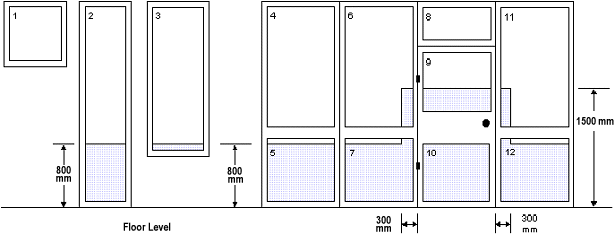The General Product Safety Regulations 2005 |
Glass Hazards
Where glass and products are supplied for domestic use (such as conservatories, garages, double glazing, porches) they must comply with the 'General Safety Requirement' of the General Product Safety Regulations 2005.
Glass fittings ins 'critical locations' in domestic buildings must be safe.
This may be achieved for example by fitting glass which breaks safely; small panes of ordinary glass; thicker ordinary glass; by protecting the glass with a permanent robust screen; or using plastics glazing sheet. Further details are given below.
What is a Critical Location?
Certain internal and external areas are considered 'critical locations' in terms of the safety of vertical glazing, as they are at risk from accidental human impact.
The 'critical locations' in any internal or external domestic area are:
Doors |
Any glazing or part of that glazing in a door, which is between the finished floor level and a height of 1500mm above the floor level, is in a 'critical location'. |
Side Panels to Doors |
Any glazing or part of that glazing, which is within 300mm of either side of a door edge and which is between the finished floor level and a height of 1500mm above the floor level, is in a 'critical location'. |
Windows, partitions, and walls |
Any glazing or part of that glazing, which is between the finished floor level and a height of 800mm above the floor level, is in a 'critical location'. |
This requires consumer products to be reasonably safe and this may be achieved by conforming with British Standard BS 6262: Part 4: 1994 (as detailed below) with reference to the Approved Document N of the Building Regulations 1991.
EXAMPLES OF LOCATIONS
Diagram 1 below gives examples of glazing in windows, partitions, walls, doors and side panels. 'Critical locations' are shaded grey. Any glazing within a shaded area must comply with BS 6206.
In Diagram 1, glazing unit No. 10 falls wholly within a 'critical location' and so the glazing must comply with BS 6206.
Where only part of a glazing unit falls within a 'critical location' the whole of that unit must comply with BS 6206. In Diagram 1 this applies to units Nos. 2, 3, 5, 6, 7, 9, 11 and 12.
In Diagram 1 only glazing units Nos. 1, 4 and 8 fall wholly outside the 'critical location' and need not comply with BS 6206.
Diagram 1
Glazing in Windows, Partitions Glazing in Doors and Side Panels and Walls

What glazing is "safe" ?
Safety Glass and Safety Plastics
Safety glass, which complies with BS 6206' may be fitted in 'critical locations'. This standard requires the glass to pass stringent tests involving impacts from a "punch bag" containing lead shot. Providing the glass does not break or breaks safely it is categorised as Class A, B, or C with A being the highest grade of safety glass.
Different types of glass can be classified as safety glass:
Toughened Glass (also called tempered) categorised - Class A
|
This looks like ordinary glass but receives a special heat treatment process to toughen it. It is much stronger than ordinary glass and on impact disintegrates into small granular pieces, which are not sharp, reducing the risk of injury. |
Laminated Glass - Class A, B or C |
Consists of two or more sheets of ordinary glass which are attached together by a plastic interlayer. The plastic layer provides a barrier and on impact any broken shards of glass will remain attached to the plastic reducing the risk of injury. |
Wired Glass (also called Pyroshield safety clear/textured) - Class C |
This glass has a network/mesh of wires embedded in it. Certain types of wired glass can satisfy the impact requirements for safety glass while giving a level of fire resistance. |
Plastics Glazing Sheet |
Certain types of transparent plastic sheet can satisfy the impact requirements for safety glass. Please Note: Glass in doors and side panels may only be glazed in Class C materials where the smaller dimension is a maximum of 900mm. Where this dimension is greater than 900mm glazing categorised as Class A or B is required. |
How Do I know if it is Safety Glass?
British Standard 6206 requires that each piece of safety glazing used within 'critical locations' should be marked with the all of the following:
The glass will have a kite mark with British Standard number 'BS 6206'. |
There will be markings to identify the type of glass used i.e. 'L' for laminated, 'P' for plastics, 'T' for tempered (toughened), 'W' for wired or 'SFB' for safety film backed. |
The category of safety glass used i.e. 'Class A', 'Class B', or 'Class C' (based on its performance under impact tests) will also be shown. A suffix 'o' denotes front impact test only e.g. mirrored wardrobe doors. |
There will be an identifiable name, trademark or other identification mark of the manufacturer. If any of the above markings are lost by cutting, then the company which carries out the cutting must replace markings a) to c) and add their own identifiable name or trade mark. |
Purchase a risk assessment
Contact us to conduct a risk assessment
Additional Reading:
General Products
Translucent Surfaces, Windows & Door Panels
Glass in Furniture
Bunk Beds
Upholstery
Electric Blankets
If this free information was useful, please recommend us or like us on our Facebook Page.
 Like us on our Facebook Business Page for Free Legal Updates
Like us on our Facebook Business Page for Free Legal Updates

